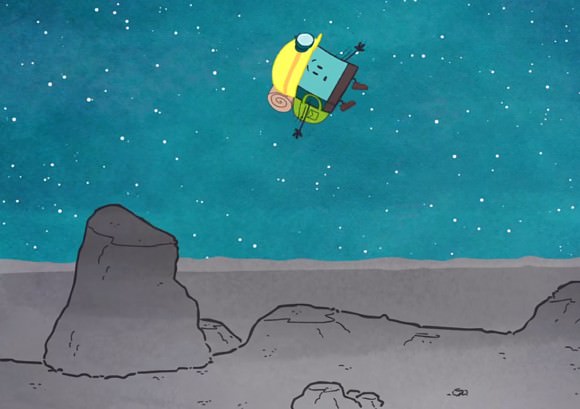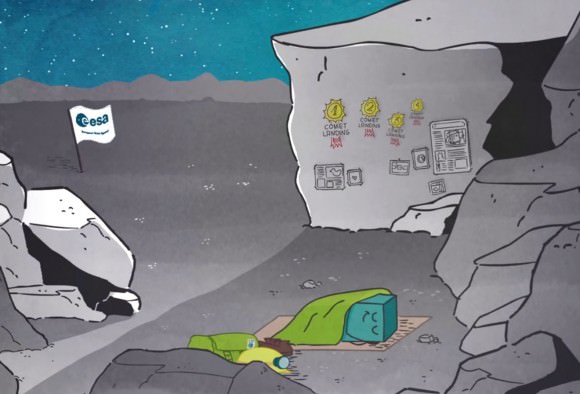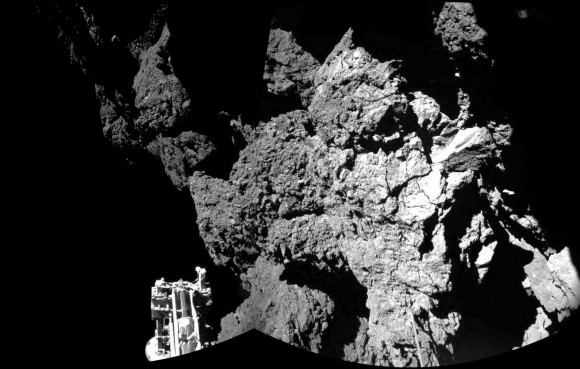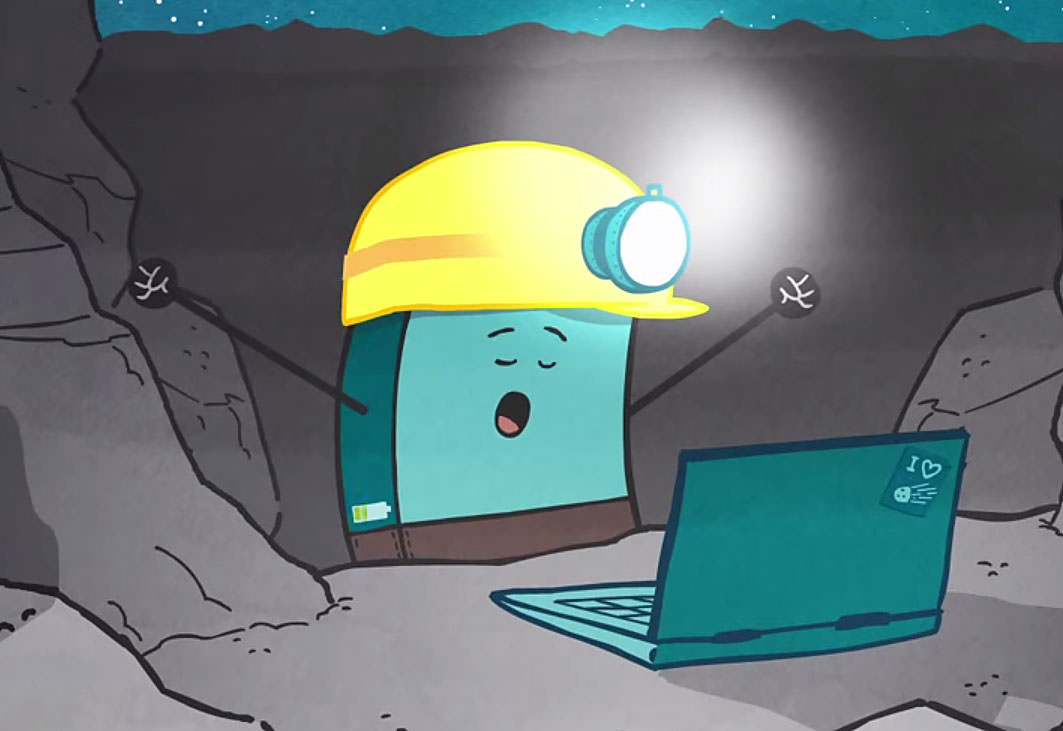Fantastic news! Philae’s alive and kicking. The lander “spoke” with its team on ground via Rosetta for 85 seconds — its first contact since going into hibernation in November.
Signals were received at ESA’s European Space Operations Center in Darmstadt at 4:28 p.m. EDT yesterday June 13. The lander sent more than 300 data packets reporting on its condition as well as information about the comet.
“Philae is doing very well. It has an operating temperature of -35ºC (-31°F) and has 24 watts available,” said DLR Philae Project Manager Dr. Stephan Ulamec. “The lander is ready for operations.”

If coming out of hibernation isn’t surprising enough, it appears Philae has been awake for a while because it included historical data along with its current status in those packets. There are still more than 8000 data packets in Philae’s mass memory which will give the mission scientists information on what happened to the lander in the past few days on Comet 67P/C-G.

Philae shut down on November 15 after about 60 hours of operation on the comet after landing at the base of a steep cliff in a shaded area that prevented the solar panels from charging its batteries. Since March 12, the Rosetta lander has been “listening” for a signal from the lost lander.

Throughout, mission scientists remained hopeful that the comet’s changing orientation and increase in the intensity of sunlight as it approached perihelion would eventually power up the little lander. Incredible that it really happened.
Yesterday, we looked at the many attempts to find Philae. A day later it’s found us!
Both amateurs and professional astronomers across the world are in constant contact sharing observations of Comet 67P/C-G and news from the Rosetta mission. Klim Churyumov, co-discoverer of the comet, had this to say upon hearing the news of Philae’s awakening:
“Hurrah! Hurrah! Hurrah! Landing probe Philae awake! Everybody, please accept my sincere congratulations! It happened on 13 June 2015 in the day of birthday of my mother – Antonina Mikhailovna (108 years have passed since the day of her birth). And I’m starting from 13 November 2014 to this day, every morning pronounced a short prayer: “Lord, please wake Philae and support Rosetta”. God and the Professional Navigators woke Philae! It is fantastic! All the best! – Klim Churyumov.
How poignant Philae awoke on Klim’s mother’s birthday!

Churyumov made his statement on the Pro-Am Collaborative Astronomy (PACA) site devoted to pro-amateur collaboration during comet observing campaigns. I encourage you to check out the group and participate by submitting your own observations of Comet 67P as it brightens this summer and early fall.
* UPDATE: In the coming days, the mission teams will reestablish contact with Philae and increase the amount of time it can “talk” with the lander. Once regular contact is established, science observations can begin again. Slowly. One instrument at a time.
The first instruments activated, those measuring temperature, magnetic fields and electrical conductivity on the comet, make small demands on Philae’s power. Slightly more power-hungry operations like picture taking and radio ranging will follow. Using the images and new data, scientists should be able to pinpoint the lander’s location.
After these steps, mission engineers will attempt to recharge the probe’s drained batteries to fire up its ovens (used to heat samples to determine their composition) and run the drill to collect fresh material.
Here’s a cool link to see LIVE telemetry from Philae.


\(^_^)/
This is Great News Bob just what the Doctor ordered now we can expect a huge amount of scientific information as the Comet swings around the Sun, I wonder if it will break in two taking the Head from the Body on its closest (and hottest) approach…
UFOs,
That would be excellent if the comet broke up. At least on the one hand. But the vast amounts of dusty debris released would surely be hazardous for Rosetta. On the other hand, 67P would probably become much brighter and easier to see from Earth.
Can’t wait to find out about the data collected while the transmitter was out of commission. I wonder if the designers made Philae shut off the radio first when the power levels became too low like when hypothermia makes an animal shut down circulation to appendages when the body core temperature falls.
Also, If 67P’s was to break up, Philae could also end up on the core moving away from the one orbited by Rosetta and lose out on all the science data because it’s out of radio range.
Lets save the core break-up for 67P’s next perihelion… 😉
Aw shucks. I just woke up a few minutes before 7AM PST. Bob, you beat me to this story. Philae is alive! And it is totally incredible!!! This is definitely my favorite comet lander of all time.
Having had the privilege to write for Universe Today, here is a past article that I totally enjoyed writing – “Rosetta’s Philae Lander: A Swiss Army Knife of Scientific Instruments” [http://www.universetoday.com/114471/rosettas-philae-lander-a-swiss-army-knife-of-scientific-instruments/]
A very very cool thing that Philae and the Rosetta orbiter will be able to do together is determine the interior structure of the comet by passing radio signals through the comet’s interior. What is inside this beastly beautiful dirty ball of ice?
Great article Tim. I woke up hearing the news just like you. They’ll also be able to use that sounding information to help pinpoint the lander.
Yes, we’ll find out who picked it out correctly from the orbiter images, out of the 3 or 4 bright pixels here or there that were candidates for being Philae. May the real Philae please stand up. Thanks Bob!
Wow, that is really a feat since it landed in November of 2015 (according to the caption), and contacted us 7 months later in June of 2015. 😉
pontzerd,
Amazing things do happen, but probably not that amazing. Thanks for pointing out the incorrect year. Now changed. Blame it on my excitement at the news.
Wow! Great news! Like Bob and Tim I flipped on the boob early this morning to catch the WX report and check the news and then heard that Phillae lives! That is so cool! Can’t wait to hear about the data…
Sunday’s are usually kind of quiet at UT (Historically it’s been Nancy or Ken checking in) so I wasn’t expecting to see anything posted about Phillae yet! Sometimes it’s good to be wrong… Bob’s ON IT! Like fur on mice and dots on dice! Nice… & thanks!
Aqua,
Dots on dice. Man, I like that.
I needed some good news this morning! Yesterday I napped in the afternoon and woke up refreshed for another night of star gazing. The previous two nights (Moonless) were amazing! Then the fog came in… so Phillea’s wake up call has chased away my “Oh God not fog again” blues!
Yay! Yay! Yay!
Can’t wait to find out what Philae has to tell us.
Excellent, let’s hope the SD2 drill can be used
I guess it was enough sunlight
(see my comment on yesterday’s UT news)
Yes!
It missed my birthday by a day or two (timezone depending) but thanks anyway. 🙂